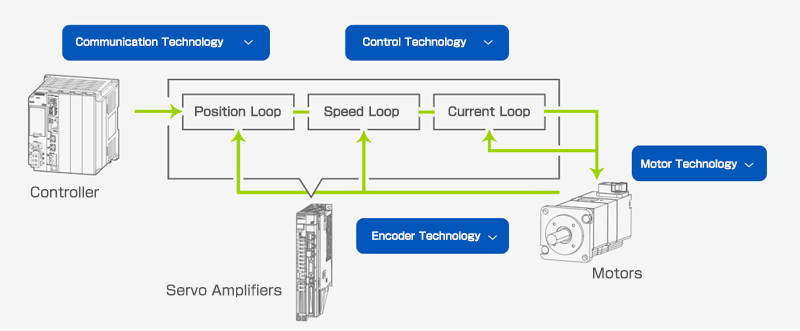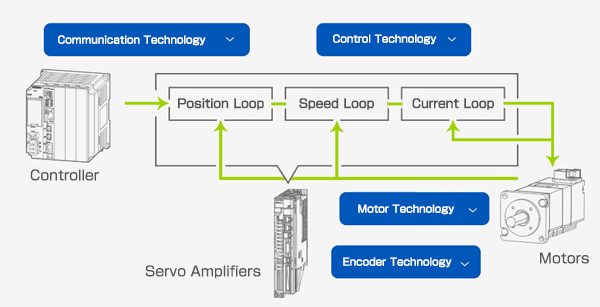Core technologies
It has been 100 years since we have driven a motor.
Yaskawa’s DNA is to be a technology-driven company. The company is committed to developing new technologies for “motors and their application” every day.
It has been 100 years since we have driven a motor.
Yaskawa’s DNA is to be a technology-driven company. The company is committed to developing new technologies for “motors and their application” every day.

Our three core technologies are:
1) Motion control
2) Robotics
3) Power conversion
These are the core competencies of the Group and are widely applied to our products.
At the heart of these core technologies is the concept of “Mechatronics.” A common term today, the word was originally coined and trademarked in 1972 as “Mechanism + Electronics” for electronically controlled mechanical devices, such as hardware motors and machines. In 2017, the Group began promoting i3-Mechatronics, which is advanced mechatronics automation that utilizes digital data. Even here, the three core technologies support various solutions. We solve our customers’ problems and create value-additions for society by applying mechatronics to new fields. We introduce to you our core technologies.



Motion control is a technology for “precisely and efficiently driving servo motors or general purpose motors, as indicated.” It is applied to a variety of machines and equipment, including machine tools used at manufacturing sites and cranes or pumps used in social infrastructure.
Motion control involves a controller to command the action of the target, and a servo motor/amplifier or AC Drive/inverter to operate the target according to the controller’s instructions. The servo amplifier controls the position, speed, and torque of the servo motor to operate it swiftly and accurately, while the AC Drive/inverter rotates the motor efficiently and appropriately. Hence, technologies for enhanced control performance are applied to each device.
Motion control technology includes motor technology, control technology, encoder technology, and communication technology.

A motor converts electrical energy into mechanical energy to drive a machine. They are classified into AC and DC motors depending on the power supply method. The AC motors are categorized into synchronous and induction motors, and synchronous motors are further categorized into SPM and IPM motors based on the position and shape of the magnets. The AC servo motor is an SPM motor with a magnet attached to the surface of the rotor. For higher torque and efficiency of the motor and smooth rotation and quiet driving, high-performance magnets, higher coil densities, and advanced design techniques are used through simulation.
Control technology is used to precisely control three elements of an object – position, speed, and torque – in response to commands received from the controller. This technology is built into the servo amplifiers and AC Drives/inverters, making it the basic technology for rotating objects in motor drives
In absolute encoders that can detect the absolute value of the rotation angle by the optical slit’s pattern, a battery is used to guarantee operation even when the power is turned off. However, battery usage is subject to maintenance requirements and rising costs. To solve this situation, we develop a batteryless technology that allows us to detect multiple revolutions without batteries, rather through magnets and coils in the encoder, and store them in non-volatile memory, even when the power is off.
When using the Internet in an office, communication speed is important. However, FA requires speed and reliable communication at regular intervals without delay. The requirements for FA equipment are to be fulfilled by a system including software and hardware. Therefore, we develop design and verification technology for ASIC (Application Specific Integrated Circuit), which is an IC chip for specific applications, to bring out the performance of FA devices for motion control and FA communication.